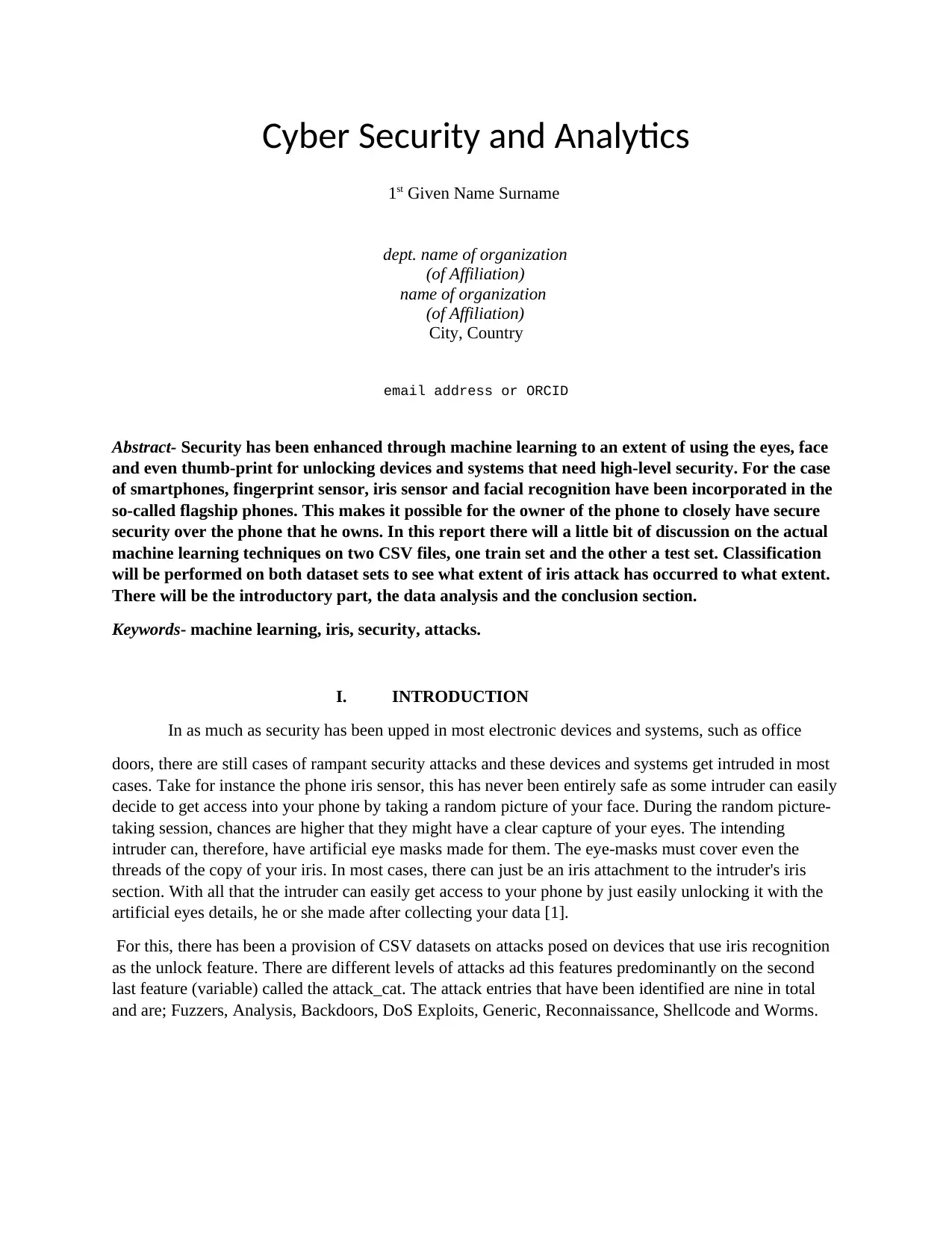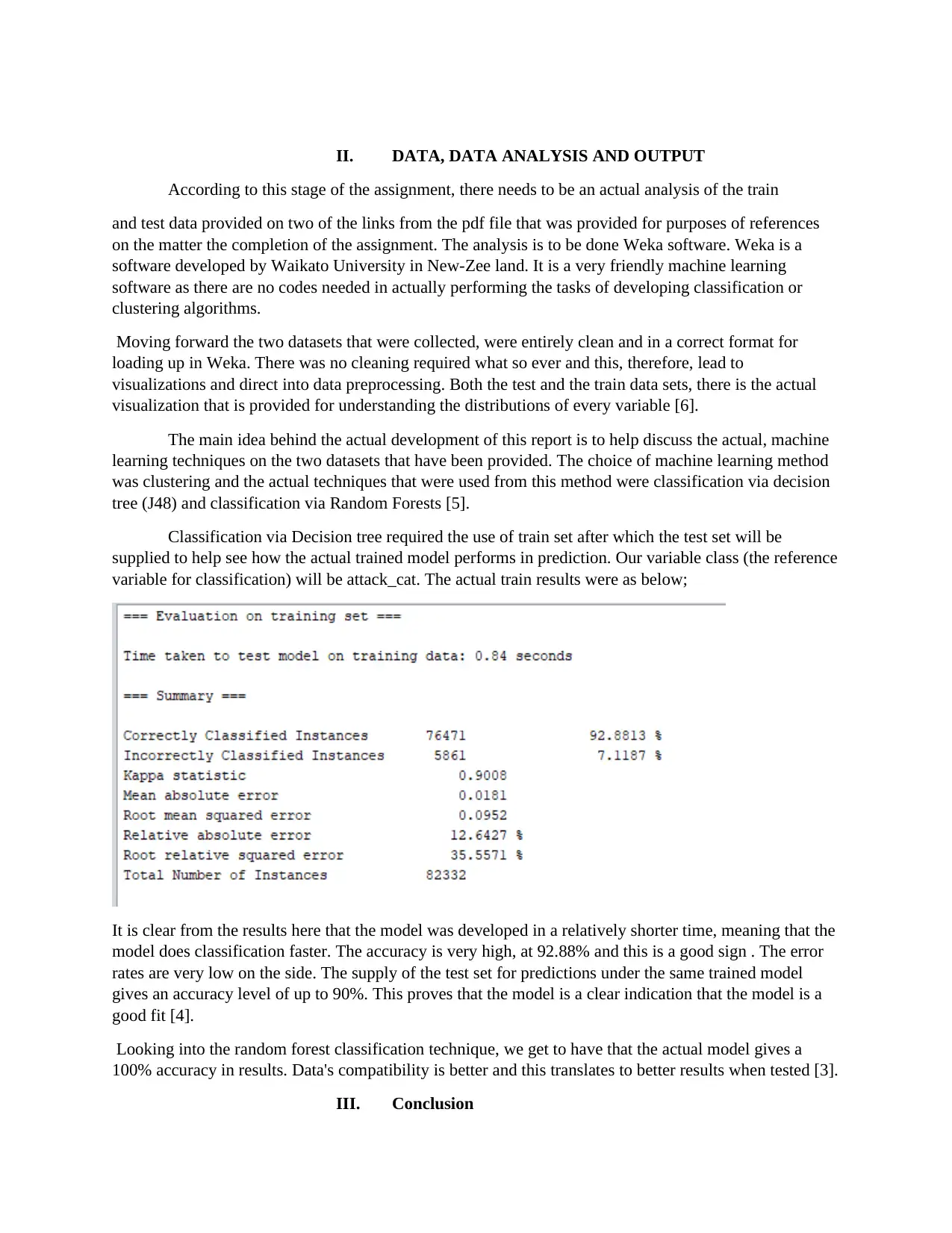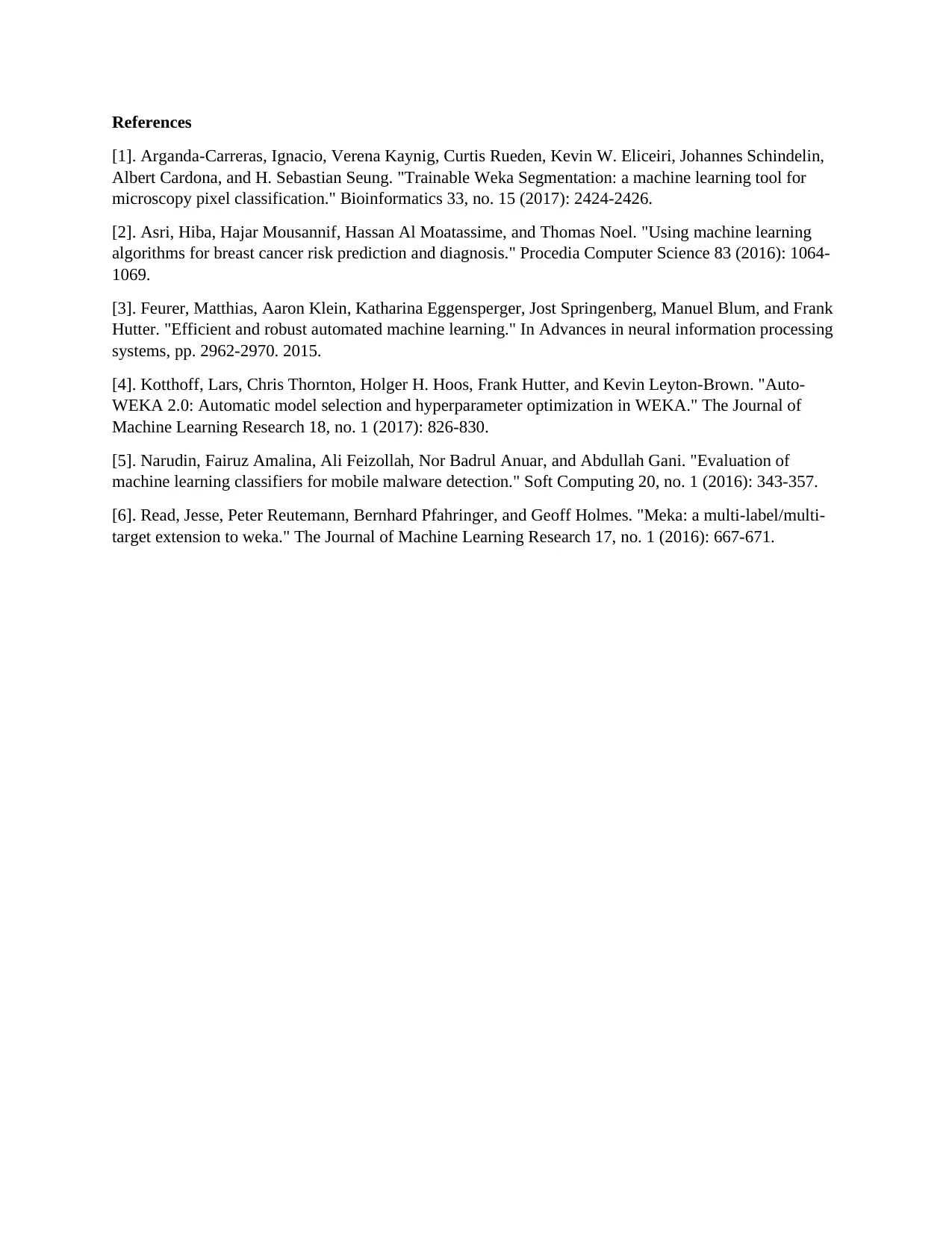MN623 Cyber Security and Analytics Report on Iris Attacks
VerifiedAdded on 2022/10/17
|4
|1195
|13
Report
AI Summary
This report delves into the realm of cyber security, specifically focusing on the analysis of iris recognition attacks using machine learning. The study employs two CSV datasets, a train set and a test set, to evaluate the effectiveness of classification algorithms in detecting and understanding the nature of these attacks. The report utilizes the Weka software for data analysis, exploring the distributions of various variables within the datasets and performing classification using decision tree (J48) and Random Forests techniques. The findings reveal that the Random Forest classification method demonstrates superior performance with 100% accuracy compared to the decision tree classification method. The report includes an introduction, data analysis, and conclusion, and it highlights the application of machine learning in enhancing security measures against iris attacks. The report aims to provide insights into the efficacy of different machine learning techniques in identifying and mitigating security threats.

Cyber Security and Analytics
1st Given Name Surname
dept. name of organization
(of Affiliation)
name of organization
(of Affiliation)
City, Country
email address or ORCID
Abstract- Security has been enhanced through machine learning to an extent of using the eyes, face
and even thumb-print for unlocking devices and systems that need high-level security. For the case
of smartphones, fingerprint sensor, iris sensor and facial recognition have been incorporated in the
so-called flagship phones. This makes it possible for the owner of the phone to closely have secure
security over the phone that he owns. In this report there will a little bit of discussion on the actual
machine learning techniques on two CSV files, one train set and the other a test set. Classification
will be performed on both dataset sets to see what extent of iris attack has occurred to what extent.
There will be the introductory part, the data analysis and the conclusion section.
Keywords- machine learning, iris, security, attacks.
I. INTRODUCTION
In as much as security has been upped in most electronic devices and systems, such as office
doors, there are still cases of rampant security attacks and these devices and systems get intruded in most
cases. Take for instance the phone iris sensor, this has never been entirely safe as some intruder can easily
decide to get access into your phone by taking a random picture of your face. During the random picture-
taking session, chances are higher that they might have a clear capture of your eyes. The intending
intruder can, therefore, have artificial eye masks made for them. The eye-masks must cover even the
threads of the copy of your iris. In most cases, there can just be an iris attachment to the intruder's iris
section. With all that the intruder can easily get access to your phone by just easily unlocking it with the
artificial eyes details, he or she made after collecting your data [1].
For this, there has been a provision of CSV datasets on attacks posed on devices that use iris recognition
as the unlock feature. There are different levels of attacks ad this features predominantly on the second
last feature (variable) called the attack_cat. The attack entries that have been identified are nine in total
and are; Fuzzers, Analysis, Backdoors, DoS Exploits, Generic, Reconnaissance, Shellcode and Worms.
1st Given Name Surname
dept. name of organization
(of Affiliation)
name of organization
(of Affiliation)
City, Country
email address or ORCID
Abstract- Security has been enhanced through machine learning to an extent of using the eyes, face
and even thumb-print for unlocking devices and systems that need high-level security. For the case
of smartphones, fingerprint sensor, iris sensor and facial recognition have been incorporated in the
so-called flagship phones. This makes it possible for the owner of the phone to closely have secure
security over the phone that he owns. In this report there will a little bit of discussion on the actual
machine learning techniques on two CSV files, one train set and the other a test set. Classification
will be performed on both dataset sets to see what extent of iris attack has occurred to what extent.
There will be the introductory part, the data analysis and the conclusion section.
Keywords- machine learning, iris, security, attacks.
I. INTRODUCTION
In as much as security has been upped in most electronic devices and systems, such as office
doors, there are still cases of rampant security attacks and these devices and systems get intruded in most
cases. Take for instance the phone iris sensor, this has never been entirely safe as some intruder can easily
decide to get access into your phone by taking a random picture of your face. During the random picture-
taking session, chances are higher that they might have a clear capture of your eyes. The intending
intruder can, therefore, have artificial eye masks made for them. The eye-masks must cover even the
threads of the copy of your iris. In most cases, there can just be an iris attachment to the intruder's iris
section. With all that the intruder can easily get access to your phone by just easily unlocking it with the
artificial eyes details, he or she made after collecting your data [1].
For this, there has been a provision of CSV datasets on attacks posed on devices that use iris recognition
as the unlock feature. There are different levels of attacks ad this features predominantly on the second
last feature (variable) called the attack_cat. The attack entries that have been identified are nine in total
and are; Fuzzers, Analysis, Backdoors, DoS Exploits, Generic, Reconnaissance, Shellcode and Worms.
Paraphrase This Document
Need a fresh take? Get an instant paraphrase of this document with our AI Paraphraser

II. DATA, DATA ANALYSIS AND OUTPUT
According to this stage of the assignment, there needs to be an actual analysis of the train
and test data provided on two of the links from the pdf file that was provided for purposes of references
on the matter the completion of the assignment. The analysis is to be done Weka software. Weka is a
software developed by Waikato University in New-Zee land. It is a very friendly machine learning
software as there are no codes needed in actually performing the tasks of developing classification or
clustering algorithms.
Moving forward the two datasets that were collected, were entirely clean and in a correct format for
loading up in Weka. There was no cleaning required what so ever and this, therefore, lead to
visualizations and direct into data preprocessing. Both the test and the train data sets, there is the actual
visualization that is provided for understanding the distributions of every variable [6].
The main idea behind the actual development of this report is to help discuss the actual, machine
learning techniques on the two datasets that have been provided. The choice of machine learning method
was clustering and the actual techniques that were used from this method were classification via decision
tree (J48) and classification via Random Forests [5].
Classification via Decision tree required the use of train set after which the test set will be
supplied to help see how the actual trained model performs in prediction. Our variable class (the reference
variable for classification) will be attack_cat. The actual train results were as below;
It is clear from the results here that the model was developed in a relatively shorter time, meaning that the
model does classification faster. The accuracy is very high, at 92.88% and this is a good sign . The error
rates are very low on the side. The supply of the test set for predictions under the same trained model
gives an accuracy level of up to 90%. This proves that the model is a clear indication that the model is a
good fit [4].
Looking into the random forest classification technique, we get to have that the actual model gives a
100% accuracy in results. Data's compatibility is better and this translates to better results when tested [3].
III. Conclusion
According to this stage of the assignment, there needs to be an actual analysis of the train
and test data provided on two of the links from the pdf file that was provided for purposes of references
on the matter the completion of the assignment. The analysis is to be done Weka software. Weka is a
software developed by Waikato University in New-Zee land. It is a very friendly machine learning
software as there are no codes needed in actually performing the tasks of developing classification or
clustering algorithms.
Moving forward the two datasets that were collected, were entirely clean and in a correct format for
loading up in Weka. There was no cleaning required what so ever and this, therefore, lead to
visualizations and direct into data preprocessing. Both the test and the train data sets, there is the actual
visualization that is provided for understanding the distributions of every variable [6].
The main idea behind the actual development of this report is to help discuss the actual, machine
learning techniques on the two datasets that have been provided. The choice of machine learning method
was clustering and the actual techniques that were used from this method were classification via decision
tree (J48) and classification via Random Forests [5].
Classification via Decision tree required the use of train set after which the test set will be
supplied to help see how the actual trained model performs in prediction. Our variable class (the reference
variable for classification) will be attack_cat. The actual train results were as below;
It is clear from the results here that the model was developed in a relatively shorter time, meaning that the
model does classification faster. The accuracy is very high, at 92.88% and this is a good sign . The error
rates are very low on the side. The supply of the test set for predictions under the same trained model
gives an accuracy level of up to 90%. This proves that the model is a clear indication that the model is a
good fit [4].
Looking into the random forest classification technique, we get to have that the actual model gives a
100% accuracy in results. Data's compatibility is better and this translates to better results when tested [3].
III. Conclusion

The performance difference between random forest and decision tree shows that the random forest is a
better performer than a decision tree classification. Random forest accuracy stands at 100% against 92%
for decision trees [2].
better performer than a decision tree classification. Random forest accuracy stands at 100% against 92%
for decision trees [2].
⊘ This is a preview!⊘
Do you want full access?
Subscribe today to unlock all pages.

Trusted by 1+ million students worldwide

References
[1]. Arganda-Carreras, Ignacio, Verena Kaynig, Curtis Rueden, Kevin W. Eliceiri, Johannes Schindelin,
Albert Cardona, and H. Sebastian Seung. "Trainable Weka Segmentation: a machine learning tool for
microscopy pixel classification." Bioinformatics 33, no. 15 (2017): 2424-2426.
[2]. Asri, Hiba, Hajar Mousannif, Hassan Al Moatassime, and Thomas Noel. "Using machine learning
algorithms for breast cancer risk prediction and diagnosis." Procedia Computer Science 83 (2016): 1064-
1069.
[3]. Feurer, Matthias, Aaron Klein, Katharina Eggensperger, Jost Springenberg, Manuel Blum, and Frank
Hutter. "Efficient and robust automated machine learning." In Advances in neural information processing
systems, pp. 2962-2970. 2015.
[4]. Kotthoff, Lars, Chris Thornton, Holger H. Hoos, Frank Hutter, and Kevin Leyton-Brown. "Auto-
WEKA 2.0: Automatic model selection and hyperparameter optimization in WEKA." The Journal of
Machine Learning Research 18, no. 1 (2017): 826-830.
[5]. Narudin, Fairuz Amalina, Ali Feizollah, Nor Badrul Anuar, and Abdullah Gani. "Evaluation of
machine learning classifiers for mobile malware detection." Soft Computing 20, no. 1 (2016): 343-357.
[6]. Read, Jesse, Peter Reutemann, Bernhard Pfahringer, and Geoff Holmes. "Meka: a multi-label/multi-
target extension to weka." The Journal of Machine Learning Research 17, no. 1 (2016): 667-671.
[1]. Arganda-Carreras, Ignacio, Verena Kaynig, Curtis Rueden, Kevin W. Eliceiri, Johannes Schindelin,
Albert Cardona, and H. Sebastian Seung. "Trainable Weka Segmentation: a machine learning tool for
microscopy pixel classification." Bioinformatics 33, no. 15 (2017): 2424-2426.
[2]. Asri, Hiba, Hajar Mousannif, Hassan Al Moatassime, and Thomas Noel. "Using machine learning
algorithms for breast cancer risk prediction and diagnosis." Procedia Computer Science 83 (2016): 1064-
1069.
[3]. Feurer, Matthias, Aaron Klein, Katharina Eggensperger, Jost Springenberg, Manuel Blum, and Frank
Hutter. "Efficient and robust automated machine learning." In Advances in neural information processing
systems, pp. 2962-2970. 2015.
[4]. Kotthoff, Lars, Chris Thornton, Holger H. Hoos, Frank Hutter, and Kevin Leyton-Brown. "Auto-
WEKA 2.0: Automatic model selection and hyperparameter optimization in WEKA." The Journal of
Machine Learning Research 18, no. 1 (2017): 826-830.
[5]. Narudin, Fairuz Amalina, Ali Feizollah, Nor Badrul Anuar, and Abdullah Gani. "Evaluation of
machine learning classifiers for mobile malware detection." Soft Computing 20, no. 1 (2016): 343-357.
[6]. Read, Jesse, Peter Reutemann, Bernhard Pfahringer, and Geoff Holmes. "Meka: a multi-label/multi-
target extension to weka." The Journal of Machine Learning Research 17, no. 1 (2016): 667-671.
1 out of 4
Your All-in-One AI-Powered Toolkit for Academic Success.
+13062052269
info@desklib.com
Available 24*7 on WhatsApp / Email
![[object Object]](/_next/static/media/star-bottom.7253800d.svg)
Unlock your academic potential
Copyright © 2020–2025 A2Z Services. All Rights Reserved. Developed and managed by ZUCOL.